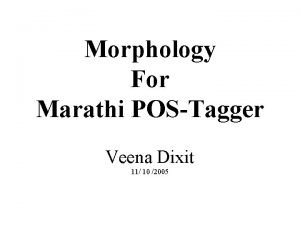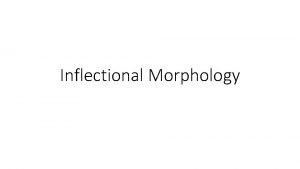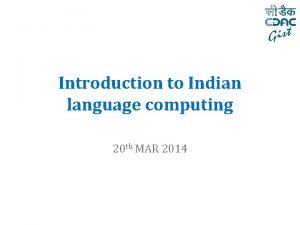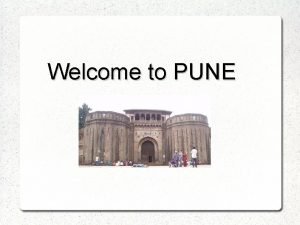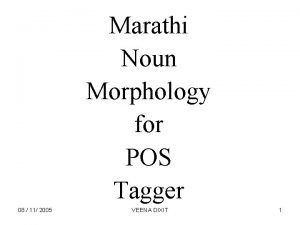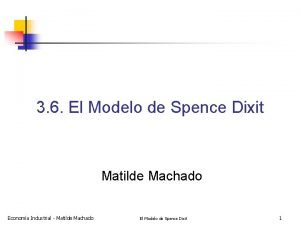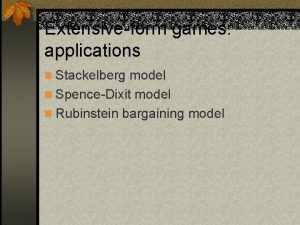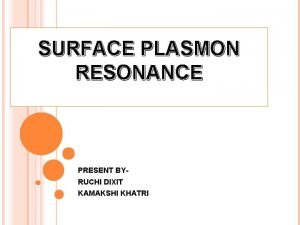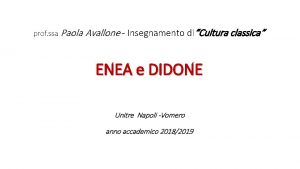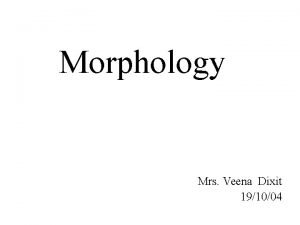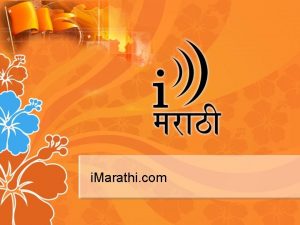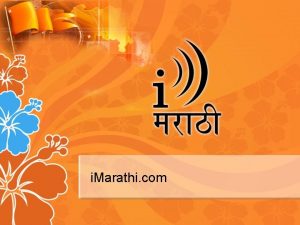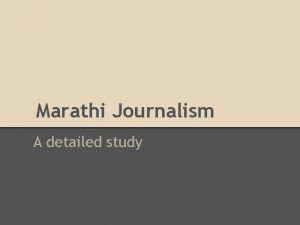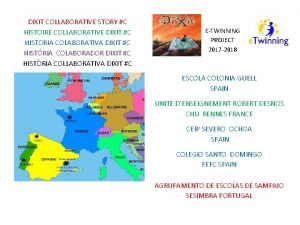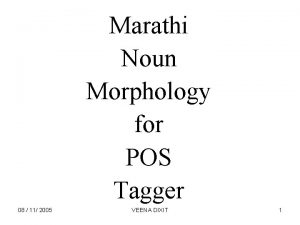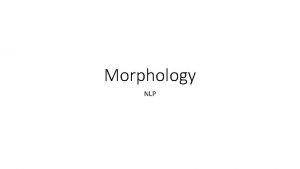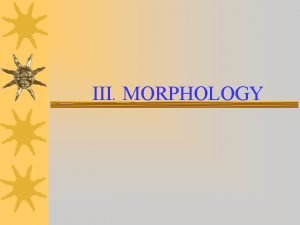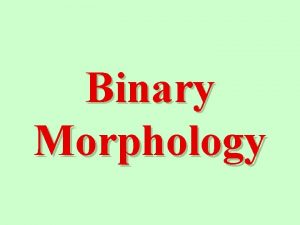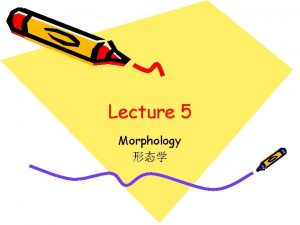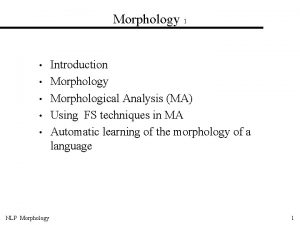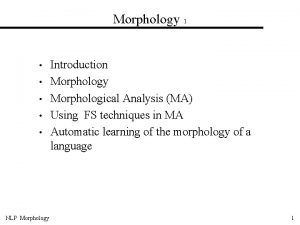Morphology For Marathi POSTagger Veena Dixit 11 10



















- Slides: 19

Morphology For Marathi POS-Tagger Veena Dixit 11/ 10 /2005

Contents • Word • Morphology • Marathi Morphology - definition of the task and difficulties thereto. • Marathi Morphology - solutions to the challenges • Different word classes • Postpositions • Particles • Interjections • Conjunctions • Pronouns • Adjectives • Adverbs • Verbs • Nouns

• Words are the orthographical strings separated by spaces and some punctuation marks. • To syntax, words make sentences and to morphology, word has internal structure and has different inflectional forms. • Inflectional forms of a root word form a paradigm based on a principle. • Root word is the form which is stored in lexicons / dictionaries.

What is Morphology? • Morphology is the study of forms of words in the language, especially the different forms used in declensions, conjugations, and word building. It deals with the morphemes. • Morpheme is a term which refers to the smallest component of a word that (a) seems to contribute some sort of meaning, or a grammatical function to the word to which it belongs, and (b) cannot be decomposed into smaller morphemes.

Marathi Morphology Definition of the task and difficulties thereto • Morphological analysis of Marathi plays significant role in natural language processing because Marathi, a pan Indian Language, is rich in morphology. • Marathi, being the language of the area situated centrally, gets influenced by almost all language groups of India. • This makes the Marathi morphology more complicated.

Marathi Morphology solutions to the challenges • Morphological analysis is done category wise. • Parameters for changes in the root word are identified. • Rules are constructed in the tabular form to facilitate computation.

Marathi Word Classes • • • Nouns Pronouns Adjectives Verbs Adverbs Postpositions Conjunctions Interjections Particles Punctuation Mark

Postpositions • Postposition is the morpheme that follows the words and shows the relation between the word that is followed and other word in the sentences. • Case markers and shabdayogi avyaya are classified as postpositions in Marathi because they show same behavior. (ref. ‘Classification of Words’, Veena Dixit, proceedings of 26 th AICL, Shilong, 2004 )

Postpositions (continued) • In Marathi, postpositions are attached to all classes of words except interjection. examples • When a postposition is attached to a stem it produces mainly adverb, but also, adjective and conjunction. • Postpositions are handled along with other word classes. • 5 subgroups of postpositions are identified on the basis of what is the possible order of their attachment and to which group of words they can be attached.

Particles • Strings like ह – hi_also , च – cha_only , सदध – suddha_also , are – sometimes attached to other words (e. g. . ख ल – khaali _under – ख ल सदध khaalisuddhaa_under also / झ ड - jhaa. Da _ tree झ डसदध - jhaa. Dasuddhaa _ tree also( – or sometimes they are written separately (e. g. . झ ड ख ल - jhaa. Daakhaali_ under the tree – झ ड ख ल सदध - jhaa. Daakhaalisuddhaa_ under the tree also). • When such words are attached to other words, the word to which it is attached, does not get inflected.

Interjections • Interjections are identified from the lexicon and stored to produce the tag. Conjunctions • Conjunctions are identified from the lexicon and stored to produce the tag. • Morphology also plays a role in the case of conjunctions.

Conjunctions (continued) • When some of Marathi postpositions are attached to a pair of demonstrative pronouns, they produce a pair of conjunctions in some instances. ज – जय प सन (jo – jyaapaasuna --- which – from त (to – tyaapaasuna --- that – from which) – तय प सन that) जय प सन नकक च क ल सरव त कल , तय प सन आज सरव त कर यल नक . – jyaapaasuna kaala suruvaata keli, tyaapaasun aaja nakkicha suruvaata karaayalaa nako_One should not start from the (same point) from which it was started yesterday.

Pronouns • Number of inflected forms of a pronoun and the rules describing such inflection are almost equal in number. • Number of pronouns and their respective inflected forms are finite and less when compared to verbs and nouns. • All inflected forms of the pronouns will be stored to produce the tag for pronoun. • Derivational morphology of pronoun is handled with rules.

Pronouns (continued) Inflectional forms of pronouns act either as adjectives (म झ – maajhaa_my) or as adverbs (मल – malaa_to me ) or as conjunctions (ज – जय प सन (jo – jyaapaasuna --- which – from which) त – तय प सन (to – tyaapaasuna --that – from that)).

Pronouns (continued) • All together 29 pronouns have 526 inflectional forms, which are either words or stems. • 21 paradigms are identified generating several rules.

Adjectives • Adjectives are mainly, inflectional and non inflectional. • Adjectives inflect for gender, number and attachment of postposition to the noun they modify. • Adjectives in Marathi agree in gender and number with the nouns they modify.

Adjectives (continued) • All inflectional adjectives belong to one paradigm, which corresponds to several rules for generating inflectional and derivational forms from an adjective. • Most of ‘aa’ ending adjectives agree with masculine nouns and further get inflected according to the gender and number of the noun they modify. (म कळय / म कळ / _moka. Laa / moka. Li / moka. Le / moka. Lyaa_empty) • There are some exceptions to this rule, such as, (ज द - jaada_extra, न न – naanaa_different, व य vaayaa_wasted).

Adverbs • Adverbs are mainly, inflectional and non inflectional. • Adverbs inflect for attachment of postpositions. ख ल – (khaali_under –-- ख लप सन – khaalapaasuna _from the underneath)

Verbs and Nouns will be discussed in next sessions. Thank you. Veena Dixit 11/ 10 /2005
 Morphology in marathi
Morphology in marathi Veena shatrugna
Veena shatrugna Veena radhakrishnan
Veena radhakrishnan Diactomy
Diactomy Derivational morphology and inflectional morphology
Derivational morphology and inflectional morphology Unicode sakal marathi font free download
Unicode sakal marathi font free download Mcsr joining time rules in marathi
Mcsr joining time rules in marathi Hbyc visit days
Hbyc visit days Welcome to pune
Welcome to pune Dare to fail meaning
Dare to fail meaning Nuhm maharashtra
Nuhm maharashtra ललर
ललर Kimaya dixit
Kimaya dixit Modelo de spence
Modelo de spence Spence dixit model
Spence dixit model Dixit surface technology
Dixit surface technology Uma dixit
Uma dixit Dixit
Dixit Interea magno misceri murmure caelum
Interea magno misceri murmure caelum Aea continuing education
Aea continuing education
